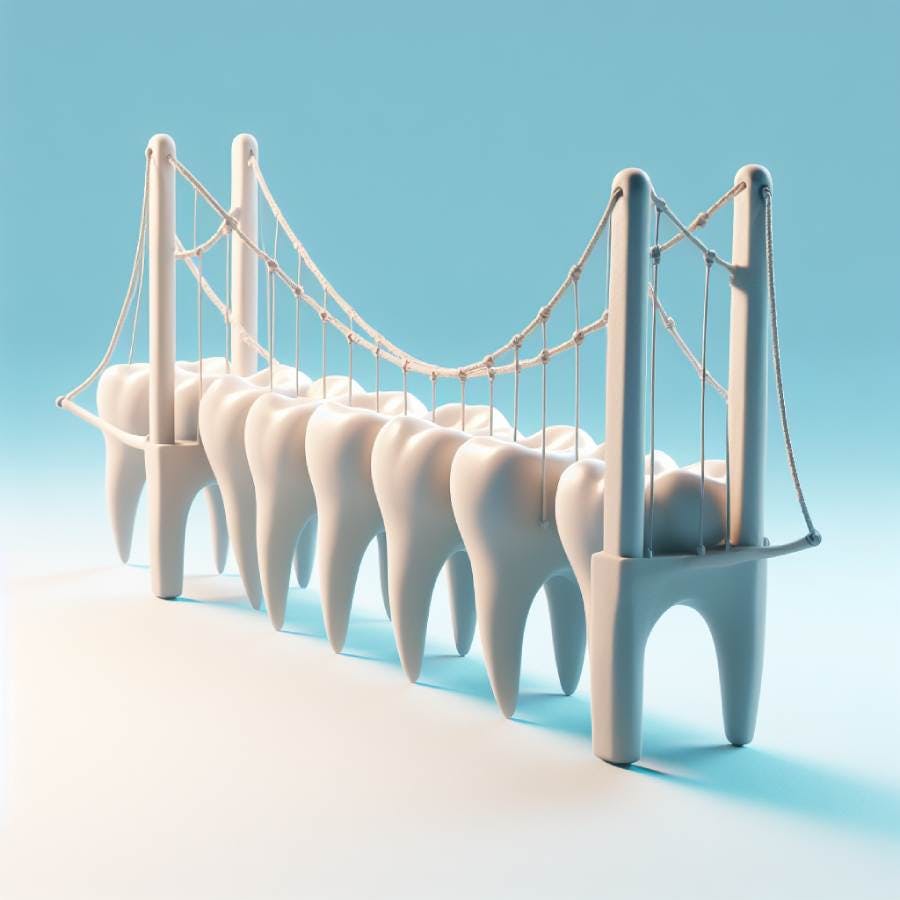Posted by Dr. Taner Cakmak on Thu, 30 Nov 2023
Uncover the importance of dental bridges: restoring function, preventing tooth shifting, and enhancing aesthetics. Explore the procedure, types, and considerations. Consult Dr. Taner Cakmak for personalized bridge solutions

Why Do I Need Dental Bridges?
Dental bridges are prosthetic devices used to replace one or more missing teeth. There are several reasons why someone might need dental bridges:
-
Tooth Replacement:
The primary purpose of dental bridges is to replace missing teeth. Gaps in your smile can affect your appearance and may lead to issues with speech and chewing.
-
Restoring Function:
Bridges help restore the proper functioning of your mouth by providing a stable and functional biting surface. This can improve your ability to chew and speak properly.
-
Preventing Shifting of Teeth:
When a tooth is missing, the adjacent teeth may start to shift into the empty space over time. This can lead to misalignment of teeth and bite issues. A dental bridge fills the gap and prevents neighboring teeth from shifting.
-
Maintaining Facial Structure:
Missing teeth can contribute to changes in facial structure, leading to a sunken appearance. Dental bridges help maintain the natural shape of your face by preventing the collapse of facial muscles and supporting tissues.
-
Enhancing Aesthetics:
Dental bridges are designed to look natural and match the color and shape of your existing teeth. This enhances the aesthetic appearance of your smile, boosting your confidence and self-esteem.
-
Distributing Bite Forces:
When a tooth is missing, the remaining teeth may bear more force during biting and chewing. This uneven distribution of forces can lead to excessive wear and tear on certain teeth. A dental bridge helps distribute these forces more evenly.
-
Convenience:
Dental bridges provide a fixed and non-removable solution for tooth replacement. This can be more convenient for individuals who prefer not to deal with removable dentures.
-
Stability for Adjacent Teeth:
By filling the gap left by a missing tooth, dental bridges provide stability to the adjacent teeth. This helps maintain the proper alignment of surrounding teeth.
-
Quick and Predictable Treatment:
The process of getting a dental bridge is often quicker compared to some other tooth replacement options. Once the supporting teeth are prepared, the bridge can be placed relatively efficiently.
Customization:
Dental bridges can be customized to match the natural appearance of your teeth. This ensures that the bridge blends seamlessly with your existing dentition.
What Is The Procedure When Getting A Dental Bridge?
Getting a dental bridge typically involves several steps, and the process may vary slightly depending on the specific circumstances of each patient. Here's a general overview of the procedure for getting a dental bridge:
-
Initial Consultation:
During the first visit, you'll have a consultation with your dentist. They will examine your oral health, discuss your medical history, and determine if a dental bridge is the appropriate solution for you.
-
Treatment Plan and Preparation:
- If a dental bridge is recommended, a treatment plan will be developed. This includes deciding the type of bridge (traditional, cantilever, or Maryland), material (porcelain, ceramic, metal), and color that will best match your natural teeth.
- The teeth adjacent to the gap (abutment teeth) are prepared. This involves removing a small amount of enamel to make room for the crowns that will anchor the bridge.
-
Impressions and Temporary Bridge:
- Impressions of your teeth are taken to create a mold for the dental bridge. This mold is sent to a dental laboratory where the bridge is custom-made.
- While the permanent bridge is being fabricated, your dentist may place a temporary bridge to protect the exposed teeth and gums.
-
Bridge Fitting and Adjustment:
- Once the permanent bridge is ready, you'll return to the dentist for the fitting. The dentist will check the fit, color, and overall appearance of the bridge.
- Adjustments may be made to ensure a proper fit and comfortable bite.
-
Permanent Placement:
- Once you and your dentist are satisfied with the fit and appearance, the dental bridge is permanently cemented into place.
- The bridge is secured by attaching the crowns to the prepared abutment teeth, filling the gap left by the missing tooth or teeth.
-
Post-Placement Care and Instructions:
Your dentist will provide instructions on how to care for your new dental bridge, including proper oral hygiene practices.
-
Adapting to the Bridge:
It may take some time to adjust to the feel of the bridge in your mouth. Initially, you might be cautious with certain foods, and your speech may be affected temporarily.
Important Considerations:
-
The dental bridge procedure is generally well-tolerated, but local anesthesia may be used during the preparation of the abutment teeth to minimize discomfort.
-
Dental bridges are a long-term solution, but they may need replacement over time due to wear and tear.
-
Good oral hygiene practices, including regular brushing and flossing, are crucial for maintaining the health of the supporting teeth and the bridge.
Dental Bridge Alternative Treatment
If you are unable to undergo dental implant treatment, a dental bridge can be a viable alternative for replacing missing teeth. Dental bridges are prosthetic devices that consist of one or more artificial teeth (pontics) supported by adjacent natural teeth or dental implants.
There are different types of dental bridges, and the most common ones include:
-
Traditional Bridge:
This type involves creating a crown for the tooth or implant on either side of the missing tooth, with a pontic (false tooth) in between. The crowns are then cemented onto the natural teeth or attached to dental implants to provide support for the bridge.
-
Cantilever Bridge:
Cantilever bridges are used when there are adjacent teeth on only one side of the missing tooth or teeth. The pontic is supported by a crown on one side only.
-
Maryland (Resin-Bonded) Bridge:
This type of bridge involves a metal or porcelain framework that is bonded to the backs of the adjacent teeth. Maryland bridges are often used when the missing tooth is in the front of the mouth.
Dentist Kanata
We will gladly answer any questions you may have.
Ask QuestionsKanata South Dental offers the ability to request your dentist appointments online. Schedule an appointment now!
Book OnlineBy filling out the New Patient Forms ahead of time you will save significant time on your visit.
New Patient FormsLatest News
Veneers vs. Implants: What's the Difference and Which One is Right for You?
Fri, 17 Oct 2025If you're looking to improve your smile, you’ve probably come across two popular dental treatments: veneers and implants. While both can make a big differen...
Continue Reading